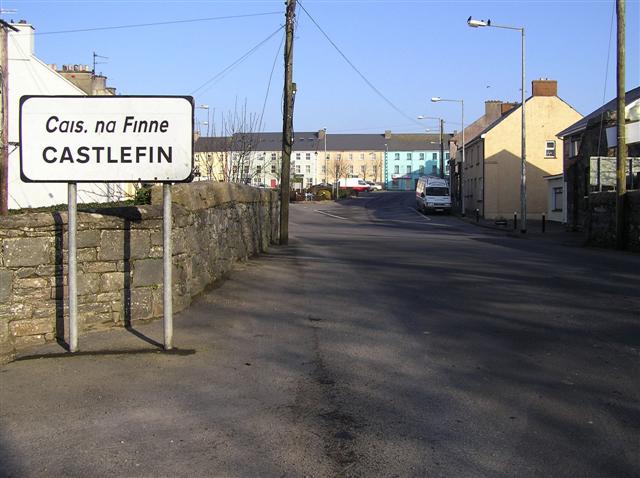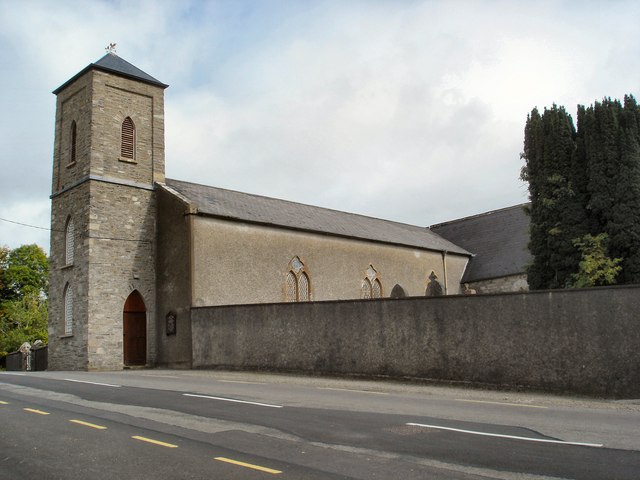|
Castlefinn Railway Station
Castlefinn railway station served the village of Castlefin in County Donegal, Republic of Ireland, Ireland. The station opened on 7 September 1863 on the Finn Valley Railway line from Strabane to Stranorlar. It closed on 1 January 1960. Routes References Disused railway stations in County Donegal Railway stations opened in 1863 Railway stations closed in 1960 {{Ireland-railstation-stub ... [...More Info...] [...Related Items...] OR: [Wikipedia] [Google] [Baidu] |
County Donegal
County Donegal ( ; ga, Contae Dhún na nGall) is a county of Ireland in the province of Ulster and in the Northern and Western Region. It is named after the town of Donegal in the south of the county. It has also been known as County Tyrconnell (), after the historic territory of the same name, on which it was based. Donegal County Council is the local council and Lifford the county town. The population was 166,321 at the 2022 census. Name County Donegal is named after the town of Donegal () in the south of the county. It has also been known by the alternative name County Tyrconnell, Tirconnell or Tirconaill (, meaning 'Land of Conall'). The latter was its official name between 1922 and 1927. This is in reference to the kingdom of Tír Chonaill and the earldom that succeeded it, which the county was based on. History County Donegal was the home of the once-mighty Clann Dálaigh, whose best-known branch was the Clann Ó Domhnaill, better known in English as the O'Don ... [...More Info...] [...Related Items...] OR: [Wikipedia] [Google] [Baidu] |
Finn Valley Railway
The Finn Valley Railway (FVR) was a gauge railway in Ireland. History Incorporation The Finn Valley Railway Company was incorporated on 15 May 1860 with capital of £60,000 (). Personnel The Chairman of the directors was The 4th Viscount Lifford, whose seat was Meenglass Castle, just south-east of Ballybofey, and the Deputy-Chairman was James Thompson Macky of the Bank of Ireland in Derry. The other directors were: *Robert Collum, 1 Chester Place, Hyde Park Square, London *Edward Hunter, The Glebe, Blackheath, Kent *Maurice Ceely Maude, Lenaghan, Enniskillen *Sir Samuel Hercules Hayes, 4th Baronet, Leuaghan, Stranorlar *Robert Russell, Salthill, Mountcharles *Major Humphreys, Milltown House, Strabane The other offices of the company were: *James Alex Ledlie, Stranorlar, Secretary *Peter W. Barlow, 26 Great George Street, Westminster, Consulting Engineer *John Bower, Engineer Opening A gauge rail line between Stranorlar and Strabane was opened on 1 October 1863. Operation ... [...More Info...] [...Related Items...] OR: [Wikipedia] [Google] [Baidu] |
County Donegal Railways Joint Committee
The County Donegal Railways Joint Committee operated an extensive narrow gauge railway system serving County Donegal, Ireland, from 1906 until 1960. The committee was incorporated by an Act of Parliament in 1906, which authorised the joint purchase of the then Donegal Railway Company by the Great Northern Railway of Ireland and the Midland Railway Northern Counties Committee. History of the Donegal Railways On 1 May 1906, the Joint Committee was set up. The lines inherited by the Joint Committee totalled and were: * Finn Valley Railway (FVR) from Strabane to Stranorlar * West Donegal Railway line from Stranorlar to Donegal * The Donegal Railway Company lines between Stranorlar and Glenties, Donegal Town to Killybegs, Strabane to Derry, and Donegal Town to Ballyshannon The Joint Committee opened the Strabane and Letterkenny Railway on 1 January 1909, bringing the total mileage to . By 1912 the company owned the following assets: * Locomotives and rolling stock: 21 lo ... [...More Info...] [...Related Items...] OR: [Wikipedia] [Google] [Baidu] |
Castlefin
Castlefin (), sometimes spelt Castlefinn, is a market town and townland in the Finn Valley of County Donegal in Ulster, the northern Provinces of Ireland, province in Ireland. It is located between Ballybofey and Lifford in East Donegal and, , the population was 705. The River Finn (County Donegal), River Finn flows by the town. The town is located in along the main N15 road (Ireland), N15 national primary road, which runs from Bundoran to Lifford. The town lies 6 miles from Lifford and 8 miles from the twin towns of Ballybofey and Stranorlar. It has close links to Letterkenny, to the twin towns of Ballybofey and Stranorlar, and to West County Tyrone, Tyrone in Northern Ireland, especially with the towns of Strabane and Castlederg. Amenities The pubs in the town include McBride's, at the foot of the Long Brae beside the main road between Lifford and Ballybofey, as well as Tinney's Bar and Lynch's Tavern (aka Skins). The five housing estates in the town are called the Emmett Park ... [...More Info...] [...Related Items...] OR: [Wikipedia] [Google] [Baidu] |
Republic Of Ireland
Ireland ( ga, Éire ), also known as the Republic of Ireland (), is a country in north-western Europe consisting of 26 of the 32 counties of the island of Ireland. The capital and largest city is Dublin, on the eastern side of the island. Around 2.1 million of the country's population of 5.13 million people resides in the Greater Dublin Area. The sovereign state shares its only land border with Northern Ireland, which is part of the United Kingdom. It is otherwise surrounded by the Atlantic Ocean, with the Celtic Sea to the south, St George's Channel to the south-east, and the Irish Sea to the east. It is a unitary, parliamentary republic. The legislature, the , consists of a lower house, ; an upper house, ; and an elected President () who serves as the largely ceremonial head of state, but with some important powers and duties. The head of government is the (Prime Minister, literally 'Chief', a title not used in English), who is elected by the Dáil and appointed by ... [...More Info...] [...Related Items...] OR: [Wikipedia] [Google] [Baidu] |
Strabane
Strabane ( ; ) is a town in County Tyrone, Northern Ireland. Strabane had a population of 13,172 at the 2011 Census. It lies on the east bank of the River Foyle. It is roughly midway from Omagh, Derry and Letterkenny. The River Foyle marks the border between Northern Ireland and the Republic of Ireland. On the other side of the river (across Lifford Bridge) is the smaller town of Lifford, which is the county town of Donegal. The River Mourne flows through the centre of the town and meets the Finn to form the Foyle River. A large hill named Knockavoe, which marks the beginning of the Sperrin Mountains, forms the backdrop to the town. History Early history The locale was home to a group of northern Celts known as the Orighella as far back as the fourth century when the territories of Owen (later Tír Eoghain) and Connail (later Tír Chonaill - mostly modern County Donegal) were established, and Orighella were assimilated into the Cenél Conaill. With the arrival of Saint ... [...More Info...] [...Related Items...] OR: [Wikipedia] [Google] [Baidu] |
Stranorlar
Stranorlar () is a town, townland and civil parish in the Finn Valley of County Donegal, in Ireland. Stranorlar and Ballybofey (located on the other side of the River Finn) form ''the Twin Towns''. Transport The town is located at the junction of the N15 and N13 national primary roads. For nearly 100 years, Stranorlar was the headquarters of the County Donegal Railway system (originally the Finn Valley Railway), with services to Derry and Letterkenny via Strabane (near Lifford), to Ballyshannon and Killybegs via Donegal, and to Glenties. At its peak, the railway had 130 employees. The last train ran from Stranorlar in 1960. Stranorlar railway station was built by the Finn Valley Railway and opened on 7 September 1863 and finally closed on 6 February 1960. The old railway station was demolished to make way for a new bus garage owned and run by Bus Éireann. To celebrate the millennium, the old clock from the railway station was restored and installed in a new clock tower ... [...More Info...] [...Related Items...] OR: [Wikipedia] [Google] [Baidu] |
Clady Railway Station
Clady railway station in County Donegal, Republic of Ireland served the village of Clady, County Tyrone in the United Kingdom. The station opened on 7 September 1863 on the Finn Valley Railway line from Strabane Strabane ( ; ) is a town in County Tyrone, Northern Ireland. Strabane had a population of 13,172 at the 2011 Census. It lies on the east bank of the River Foyle. It is roughly midway from Omagh, Derry and Letterkenny. The River Foyle marks ... to Stranorlar. It closed on 1 January 1960. Routes References Disused railway stations in County Donegal Railway stations in the Republic of Ireland opened in 1863 Railway stations in the Republic of Ireland closed in 1960 {{Ireland-railstation-stub ... [...More Info...] [...Related Items...] OR: [Wikipedia] [Google] [Baidu] |
Liscooly Railway Station
Liscooly railway station served the village of Liscooly in County Donegal, Ireland. The station opened on 7 September 1863 on the Finn Valley Railway line from Strabane Strabane ( ; ) is a town in County Tyrone, Northern Ireland. Strabane had a population of 13,172 at the 2011 Census. It lies on the east bank of the River Foyle. It is roughly midway from Omagh, Derry and Letterkenny. The River Foyle marks ... to Stranorlar and closed on 1 January 1960. Routes References Disused railway stations in County Donegal Railway stations in the Republic of Ireland opened in 1863 Railway stations in the Republic of Ireland closed in 1960 {{Ireland-railstation-stub ... [...More Info...] [...Related Items...] OR: [Wikipedia] [Google] [Baidu] |
Railway Stations Opened In 1863
Rail transport (also known as train transport) is a means of transport that transfers passengers and goods on wheeled vehicles running on rails, which are incorporated in tracks. In contrast to road transport, where the vehicles run on a prepared flat surface, rail vehicles (rolling stock) are directionally guided by the tracks on which they run. Tracks usually consist of steel rails, installed on sleepers (ties) set in ballast, on which the rolling stock, usually fitted with metal wheels, moves. Other variations are also possible, such as "slab track", in which the rails are fastened to a concrete foundation resting on a prepared subsurface. Rolling stock in a rail transport system generally encounters lower frictional resistance than rubber-tyred road vehicles, so passenger and freight cars (carriages and wagons) can be coupled into longer trains. The operation is carried out by a railway company, providing transport between train stations or freight customer facilit ... [...More Info...] [...Related Items...] OR: [Wikipedia] [Google] [Baidu] |




